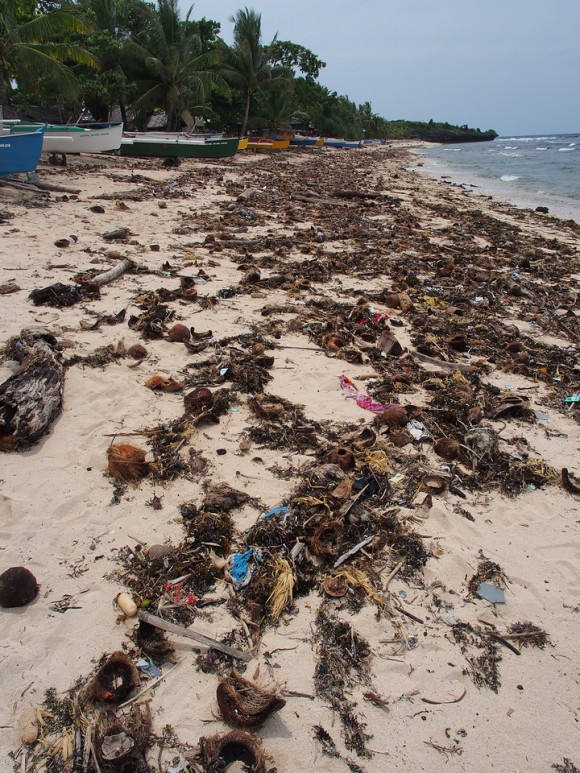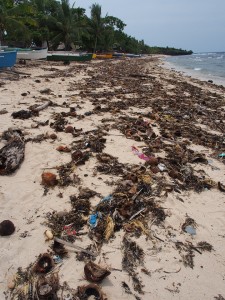A Category 1 Typhoon Hits the Philippines
Sunday September 14, 2014
7;20 a.m. San Juan, Siquijor
Room 2, Casa Miranda
The big story of the last 24 hours was the typhoon. I never did manage to get online or see any official reports, but I was told that it was a Category 1 typhoon and that it made landfall or was going to make landfall somewhere in Luzon. Here on Siquijor, we still felt major effects. It seemed to me that the typhoon was much closer than Luzon. The winds and rain here were quite strong. Power went out, of course, and this morning I noticed that power line poles were blown over up and down the street outside this guesthouse. So it’s unlikely that power will return anytime soon. It makes little difference to me, fortunately. With my battery-operated NEO and methyl-alcohol powered stove, I’m somewhat off the grid.
It’s interesting to think of damage from storms. It has occurred to me lately (particularly since typhoon Yolanda) that when you see an international news story about natural disasters around the world, you can’t really translate the scale of the damage. I just wrote that power line poles were blown down by the wind. Someone in Canada might then think of how strong the wind would have to be to blow down a power pole and conclude that the wind was very strong. However, it’s a safe bet that it would take a much stronger wind to blow down a power pole in Canada than here. They are poorly made and poorly placed here and it doesn’t take much to blow them down. The same went for schools and other buildings in Tacloban. The typhoon blasted cement buildings into a thousand bits. But that, I learned, was more a reflection of the poor quality construction standards than the power of the typhoon.
The typhoon kept me indoors most of yesterday and all of last night. I passed the time listening to podcasts and treating my various infected wounds. I was glad that I picked up a container of that anti-bacterial Katialis. I don’t think that it would have any effect if the infections had really taken hold. However, in the early stages, it appears to help in preventing the infection from progressing. The wounds were getting quite bad yesterday and getting worse quickly, but I applied Katialis constantly and it appears to have helped a lot. I’m glad of that, because left untreated, these wounds would eventually send me to a hospital. I’ve had to do that every other time that I can remember. In the past, the majority of the infections were on my feet. This time, for no reason that I can make out, they are on my upper body and legs. I’ve got five of them on my biceps, shoulders, and stomach, and four of them on the outside of my right knee. They are all extremely tender and itchy and are oozing large amounts of nasty yellow pus. However, they have stopped growing, and the hope is that they will eventually heal on their own.
It bothers me that no one else ever knows what I’m talking about when it comes to these infected wounds. I’ve gotten them on every single trip to the Philippines in my life. I noticed that the Filipinos also get them. Many people have visible scars all over their legs and feet that I assume are from these infections. I had those same round scars myself, but they’ve faded over time. Yet, I don’t think I’ve ever had one conversation where anyone knew what I was talking about. It’s frustrating, but it’s a common thing in my life. I always seem to find the one thing that that no one else has heard of. It’s not like backpackers sit around and talk about their infected wounds. I don’t think I’ve met anyone who has ever had them. And when I go to a pharmacy and show them to the pharmacist, he or she has never had any idea what they were. And I’ve never gotten a clear answer on the Internet about them. I only have vague memories of a doctor who treated me saying that the infections were caused by coral getting into your flesh and growing there. I’ve always taken that to be the answer, but I’m not sure about that. Certainly, the timeline bears that out. I get the infected wounds in the day or two following going into the ocean. Every time, there is a correlation. If I don’t go snorkeling, I don’t get the infections.
Super typhoon Yolanda was on my mind yesterday as the typhoon winds howled. I had made the effort this time of taking my bike inside. I did that basically to protect it from the constant damp and rain. I’ve been trying, as I said, to stay on top of maintenance and I’ve been cleaning all the parts and drying them and applying lubricant to try to keep rust at bay. Seawater does nasty things to bicycles. Of course, if there were a storm surge or a tsunami-like event, taking the bike inside would not have helped. My fragile little room is sitting pretty much at sea level and perhaps twenty feet from the edge of the ocean. A storm surge like the one that hit Tacloban would wash away this flimsy guest house like it wasn’t even there – and me along with it.
It makes me think of survivalists. You could say that I didn’t do nearly enough to prepare for the typhoon that hit Tacloban. That’s obvious. I would have been much better off had I done any number of a dozen things. And I can see a survivalist taking that as a lesson and making those preparations for every typhoon – just in case. Knowing a typhoon was on its way, I could have packed up everything on my bike and ridden into the interior of the island and set up my tent on a high hill. But I could do that fifty times for the rest of my life, and there would never be another storm surge like the one in Tacloban. That was a freak event and statistically very unlikely. And if I went up into the mountains and stayed in my tent, I’d probably be crushed by a tree as it fell over, hit on the head and killed by a falling coconut, or washed away in a mud slide. You just can’t win when it comes to that stuff, and if you focus on survivalism, you’d end up driving yourself crazy. And you’d make all these preparations and then start wishing a disaster would occur, so you’d be proven right.
I thought the typhoon weather would stick around for a couple of days, but the skies appear to be clearing already. It looks like I could even go out exploring on my bike and do some photography today if I were in the mood. I was making tentative plans to ride my bike the full 72 kilometers around the island, but the Spanish cyclist Carlos said that it was actually a pretty boring ride. You don’t get the beautiful coastal views that you’d expect. To see the ocean, you have to – as I always do – get off the main road and cycle down the backroads. But you can’t spend your time doing that all day and expect to make it around the island. Renting a motorcycle might be a better option. It would cost 300 pesos for one day ($7.50), but it would be fun.
I’m also not sure about my overall plans. It is the 14th today, and my flight is on the 25th. I think the 25th is a Thursday. I’ll probably plan to be back in Cebu on Monday or Tuesday. I need one day to go to immigration (with one more business day as a back-up in case something goes wrong). I was even thinking that I could just ride my bike back to Cebu instead of taking the boat. The coastal ride along Cebu was actually quite nice – much nicer than I expected. I’d likely take a boat to Dumaguette and spend the night there. Then I’d need two days of cycling to get back to Cebu. That would avoid all the hassles of taking a boat, and I’d get to see a bit more of Dumaguette.
Tags: bike, Philippines Bike Trip 2013, Siquijor, Tacloban, tent, typhoon


